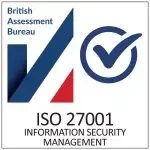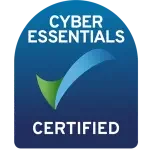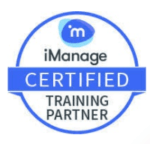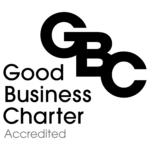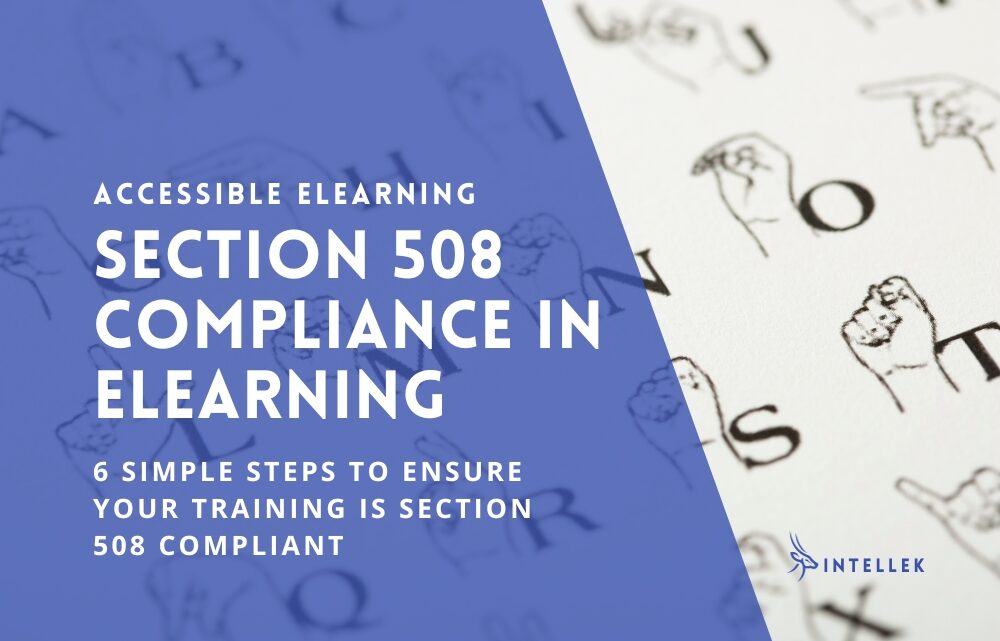

Here at Intellek, we pride ourselves on providing section 508-compliant eLearning. In this week’s blog, from our Instructional Designers, we share how we do so; and six tips on how you can ensure Section 508 Compliance eLearning in your content and online courses.
In today’s world, it’s more important than ever to make sure that all learners, regardless of ability, have equal access to education and training. That’s where 508 Compliance comes in. By following these six easy steps, you can ensure that your eLearning is inclusive and accessible for everyone.
- Stick to a Clear and Consistent Design
- Choose Colors Carefully
- Pay Attention to Font Size
- Make Navigation a Breeze
- Use Animation and Closed Captions
- Provide Audio or Text Transcripts
Unlock the Secrets of Section 508 Compliance! Dive into these 6 Simple Steps for Making eLearning Accessible for All. Read on for more context and a detailed look at each of these steps…
IN THIS ARTICLE...
What is 508 Compliance in eLearning?
In short, Section 508 of the United States Workforce Rehabilitation Act of 1973 requires that the federal government’s website information be safe and accessible for people with disabilities.
This law covers a range of issues related to assisting people with different kinds of disabilities and covers everything from Images, maps, videos, eLearning, and more.
Specific Guidelines and Requirements of Section 508 Compliance:
- Section 508 Compliance requires that all electronic and information technology (EIT) procured, developed, maintained, or used by the federal government must be accessible to people with disabilities.
- The specific guidelines for Section 508 Compliance are detailed in the Section 508 Standards and can be found on the Section 508 website.
- The guidelines cover a range of areas including the accessibility of software, hardware, and websites. Some of the key requirements for eLearning include: providing alternative text for images, using closed captions for videos, and providing transcripts for audio content.
Why do we need Section 508 Compliance?
Over the past 18 months, the Instructional Design team has been creating eLearning that is 508 Compliant. We are not a federal government, so why do we strive to be 508 Compliant?
A recent study shows a deficit of data about how educational technology can help learners with disabilities in low and middle-income countries.
While we may only receive a small number of requests for 508-compliant eLearning, primarily law schools, Intellek believes it’s essential to be compliant for all simulated courses we create.
What are the consequences of not being 508 compliant?
If an organization is not 508 compliant, it can face several consequences, including potential lawsuits and legal penalties, as well as a loss of government contracts.
Additionally, non-compliance can negatively impact the organization’s reputation and brand image. Furthermore, non-compliant eLearning content may be inaccessible to individuals with disabilities, making it difficult for these individuals to complete the training and obtain the necessary skills and knowledge.
How can an organization ensure it meets all requirements of Section 508 Compliance?
To ensure that an organization is meeting all the requirements of Section 508 Compliance, it is important to conduct regular accessibility assessments and make necessary adjustments.
The organization should also have a clear and well-documented accessibility policy in place and provide accessibility training for employees, including instructional designers and developers.
Additionally, the organization should use accessibility testing tools and have regular reviews of the eLearning content to identify and resolve any accessibility issues.
Making eLearning More Accessible
For many of our clients, ADA / 508 Compliance is handled outside of their eLearning, often through instructor-led support. This fed into our strategic thinking and we decided that, as an organization, we wanted to go beyond simply serving the market’s current demand for accessible eLearning.
Team Intellek is a diverse group of people in many different senses – we do everything we can to ensure the individual needs of all team members are met, whatever they might be. We believe in the spirit of the ADA!
Whilst we understand that many firms handle accessibility outside of eLearning, we want as many people as possible to have direct access to our learning resources. Through audio, closed captioning (like instructions), document-based job aids, and other features that make up ADA / 508 compliance eLearning.
Benefits of Making eLearning Accessible:
Making eLearning accessible for all learners, including those with disabilities, not only complies with the law but also provides numerous benefits for organizations and learners.
- Increased inclusiveness: By making eLearning accessible, organizations can reach a wider audience and create an inclusive learning environment for all learners.
- Improved User Experience: Providing accessibility features such as alternative text, closed captions, and transcripts can enhance the user experience for all learners, not just those with disabilities.
- Increased Engagement: Accessible eLearning can lead to increased engagement and motivation for learners, as they can access the content more easily and effectively.
- Better Learning Outcomes: By providing accessible eLearning, organizations can improve learning outcomes for all learners, as they are able to understand and retain the information more easily.
How does 508 compliance affect the development and design of eLearning content?
508 compliance affects the development and design of eLearning content by requiring that eLearning content be accessible to individuals with disabilities.
This means that certain features, such as alternative text for images, closed captioning for videos, and transcriptions for audio must be included in eLearning content to ensure accessibility. The use of clear, easy-to-read font sizes and simple navigation must also be considered, as well as keyboard accessibility for those with physical disabilities.
These considerations must be integrated into the design and development process from the start to ensure compliance.
How can an organization assess the accessibility of its eLearning content?
To assess the accessibility of eLearning content, an organization can use accessibility testing tools, such as screen reader software, to test the content for compatibility with assistive technology.
The organization can also conduct user testing with individuals who have disabilities to obtain feedback on the accessibility of the content.
In addition, the organization can perform manual evaluations of the eLearning content, looking for potential barriers to accessibility and making necessary adjustments. The results of these assessments should be documented and used to inform any necessary updates to the eLearning content and development process to ensure continued compliance with Section 508.
How to Make 508 Compliant eLearning
Now we’re getting to the details… 508 compliant eLearning courses. Here are our six top tips for how you can ensure section 508 compliance eLearning resources for your organization:
1. Create a Consistent Design Concept
We have over 1000 modules in our eLearning library and each course we create has a consistent structure, branding, layout, and style. The best design concept to use is clean and concise and remains uncluttered. Some learners may struggle if the content they are viewing is ‘too busy’.
We use a screen reader to test the content, ensuring that all elements on the screen appear in the proper order and can be read back to the learner.
2. Choose the Right Colors (think Color-Blind)
When creating a design, be mindful of the color contrast you use. The majority of learners who are color blind can see clearly, but colors appear different from what you and I may see.
3. Be Mindful of Font Sizes for 508 Compliance eLearning
Pay attention to the font size in your design, don’t go too small! Many Instructional Designers add the option for learners to change the font size, so either add that feature or use a minimum font size of 12pt or above.
4. Provide Easy Navigation with Keystrokes
eLearning navigation actions should be addressed by the design and style of the course, ensuring the user interface (UI) and user experience (UX) are clean and straightforward.
In addition, it’s essential to address the navigational options for those with a physical disability.
For some, it can be difficult to navigate with a mouse, so eLearning must be able to proceed using a keyboard only. In our courses, we ensure that the “Spacebar” or the “Tab” key can also be used to navigate.
5. Use Animation and Video Closed Captions
Whilst Team Intellek does not use video in our eLearning, we do use animation on occasion. It’s important to include Alt Text for images and videos as a text equivalent, be sure to enable closed captioning (subtitles) in your video content too.
Doing so ensures that a screen reader can read information to learners who may be visually impaired.
6. Use Audio or Text Transcripts for 508 Compliance
Intellek’s eLearning uses audio to help support the learner. If you’re not confident adding voiceover to your content, be sure to include a text transcript to make the information accessible to those with hearing difficulties.
Section 508 Compliance eLearning with Intellek
Don’t let accessibility be an afterthought in your eLearning design. Embrace these simple steps to make a difference for all learners and fulfill your 508 Compliance obligations. Make your eLearning content accessible and inclusive, right from the start.
If you have any questions or would like to see a demo of how our content creation tool can be used to make 508 Compliant eLearning and online courses, please feel free to reach out to us or just book yourself a free live demo.
Intellek (formerly TutorPro) is a founding member of the learning technology industry. With a presence in the USA, UK, Canada, and the EU – for over 30 years we have pioneered the development of cutting-edge eLearning software and online training solutions, with a large and diverse portfolio of international clientele.
Disclaimer: We use all the tools available including generative AI to create relevant and engaging content.
